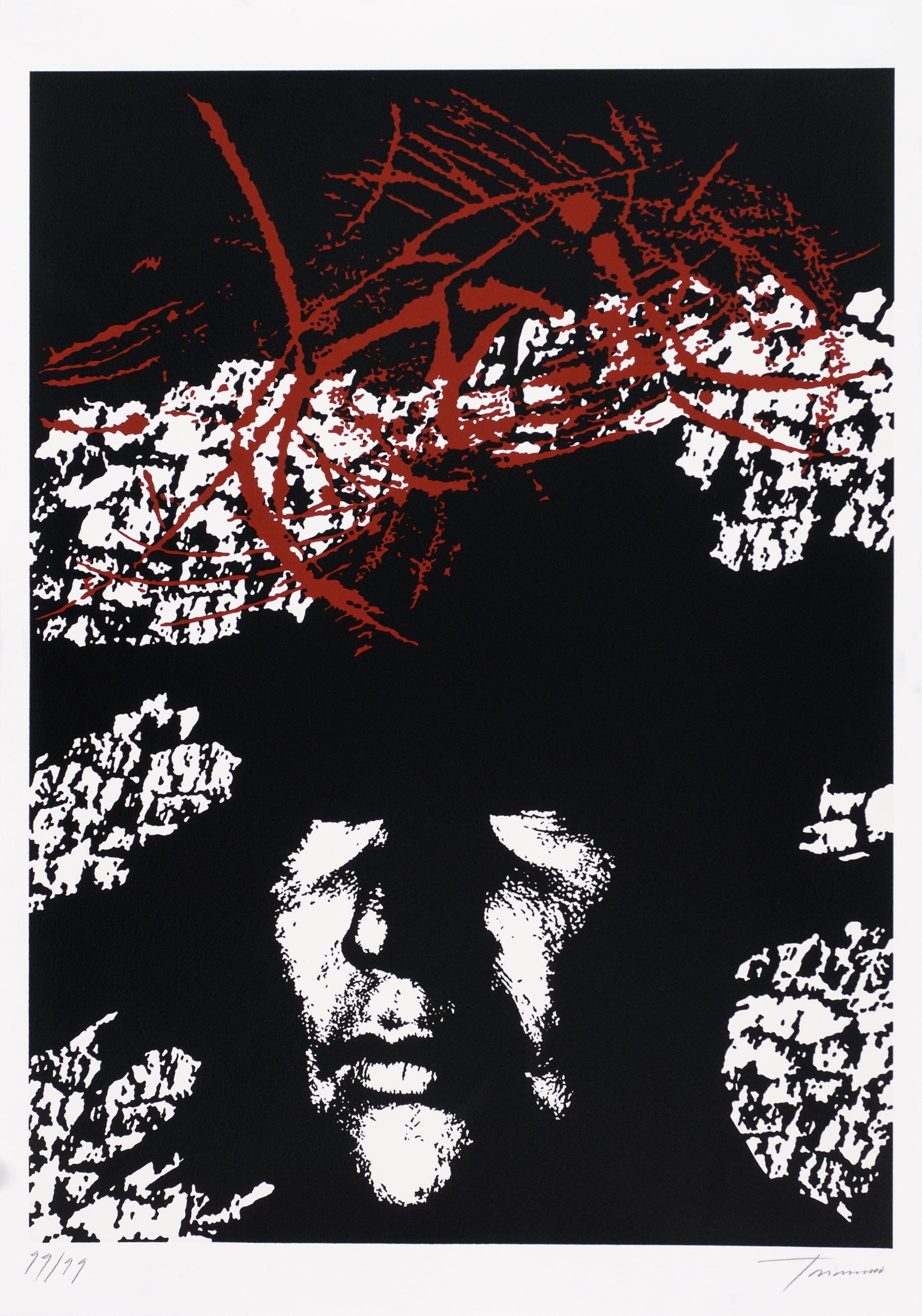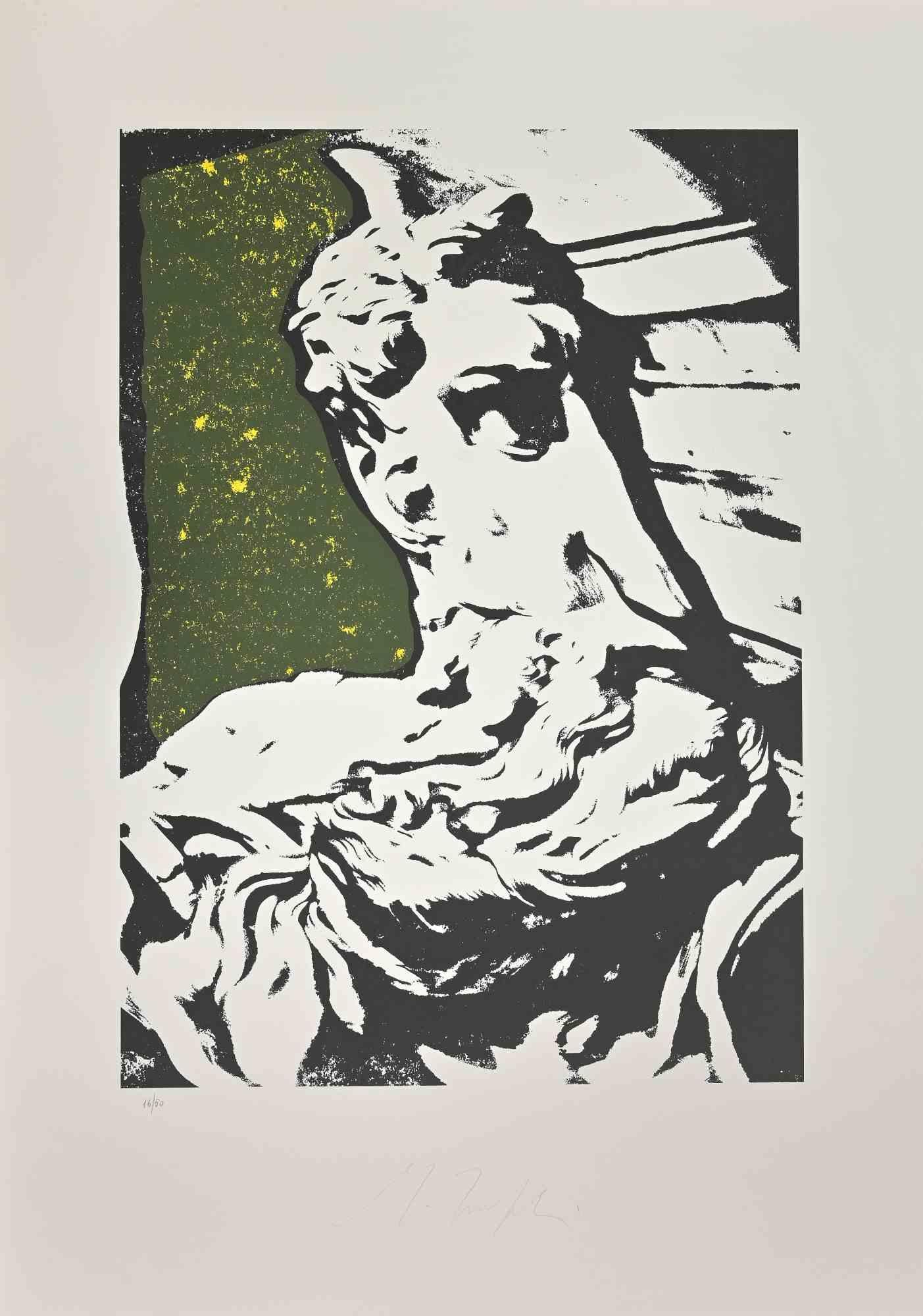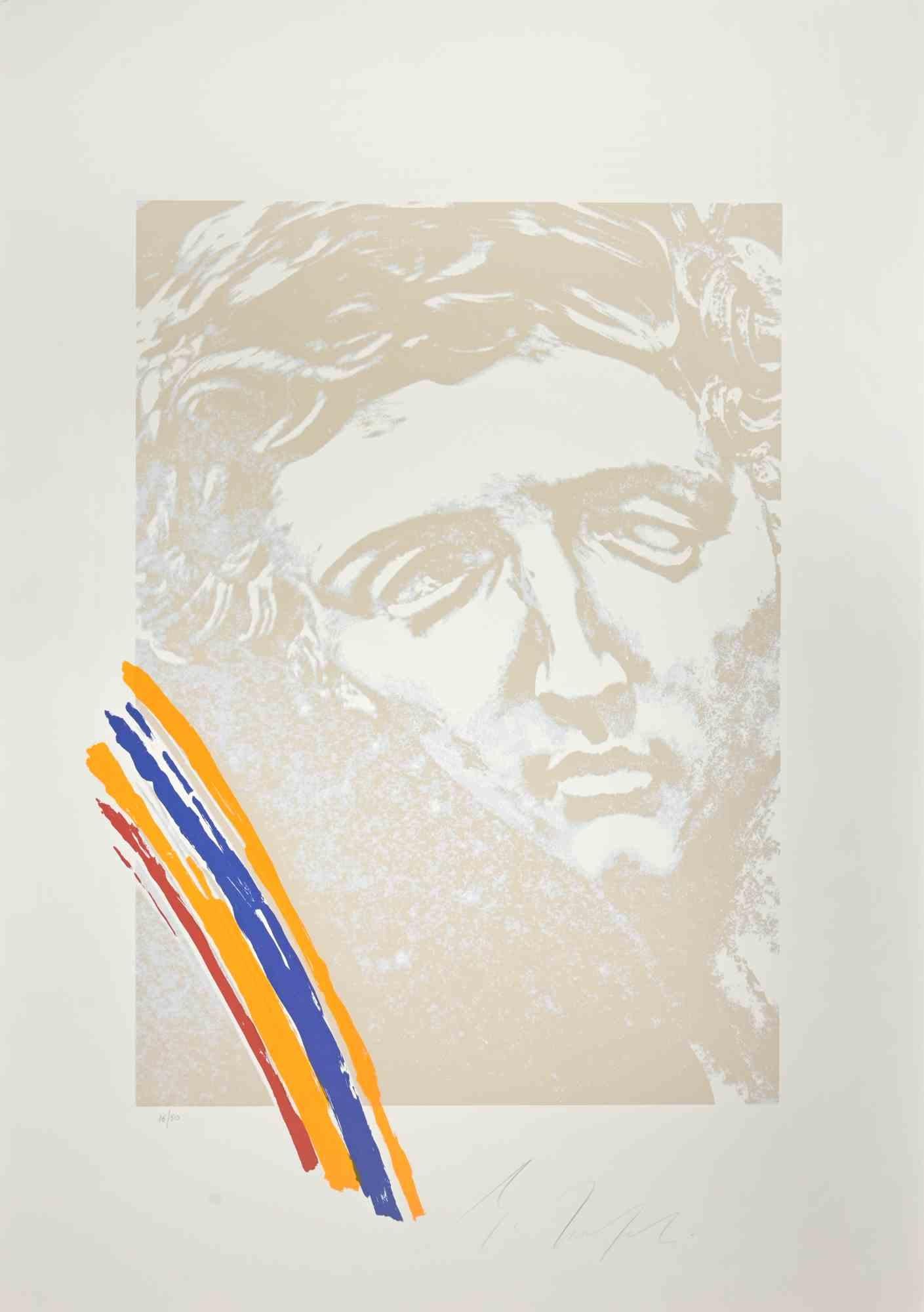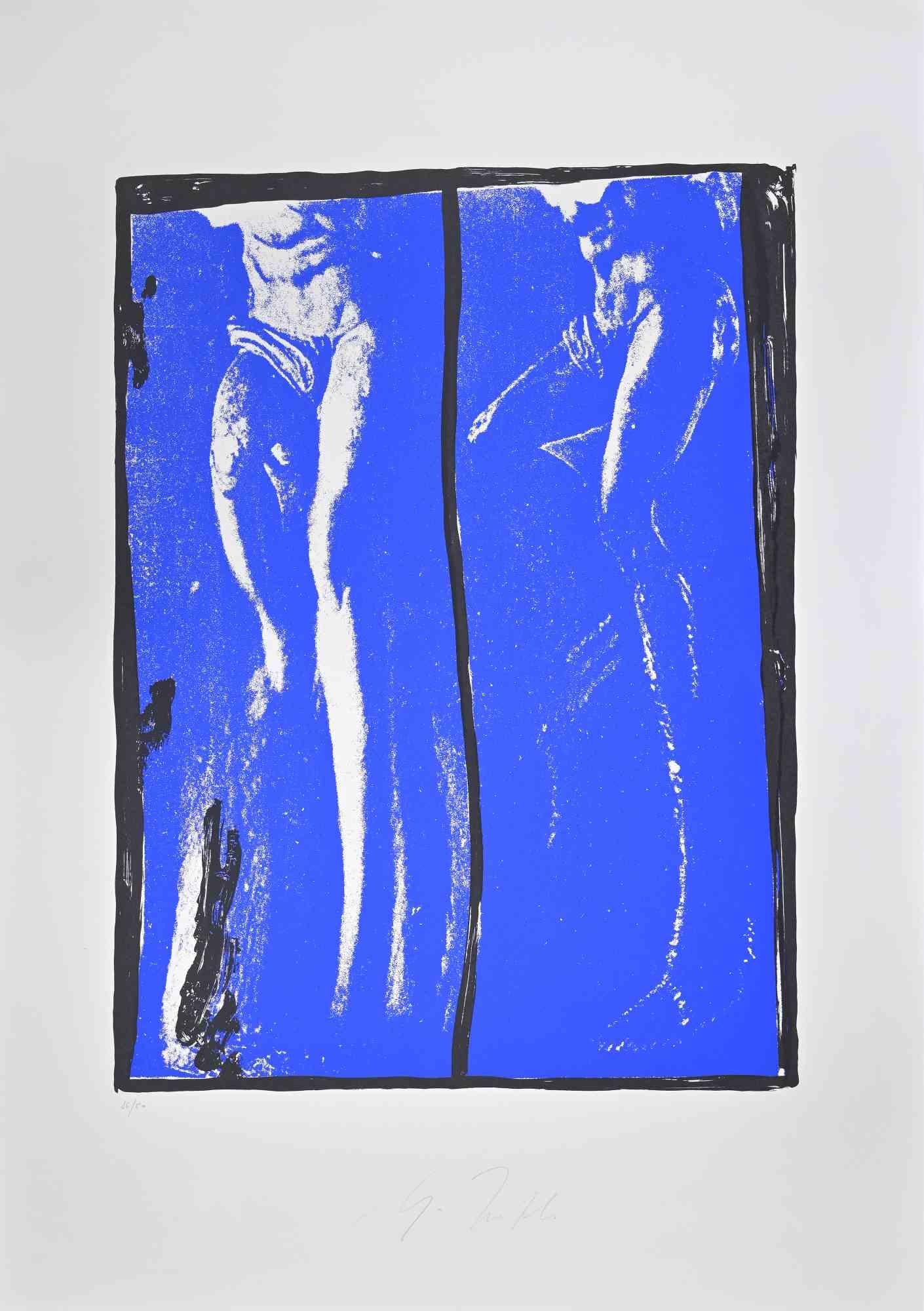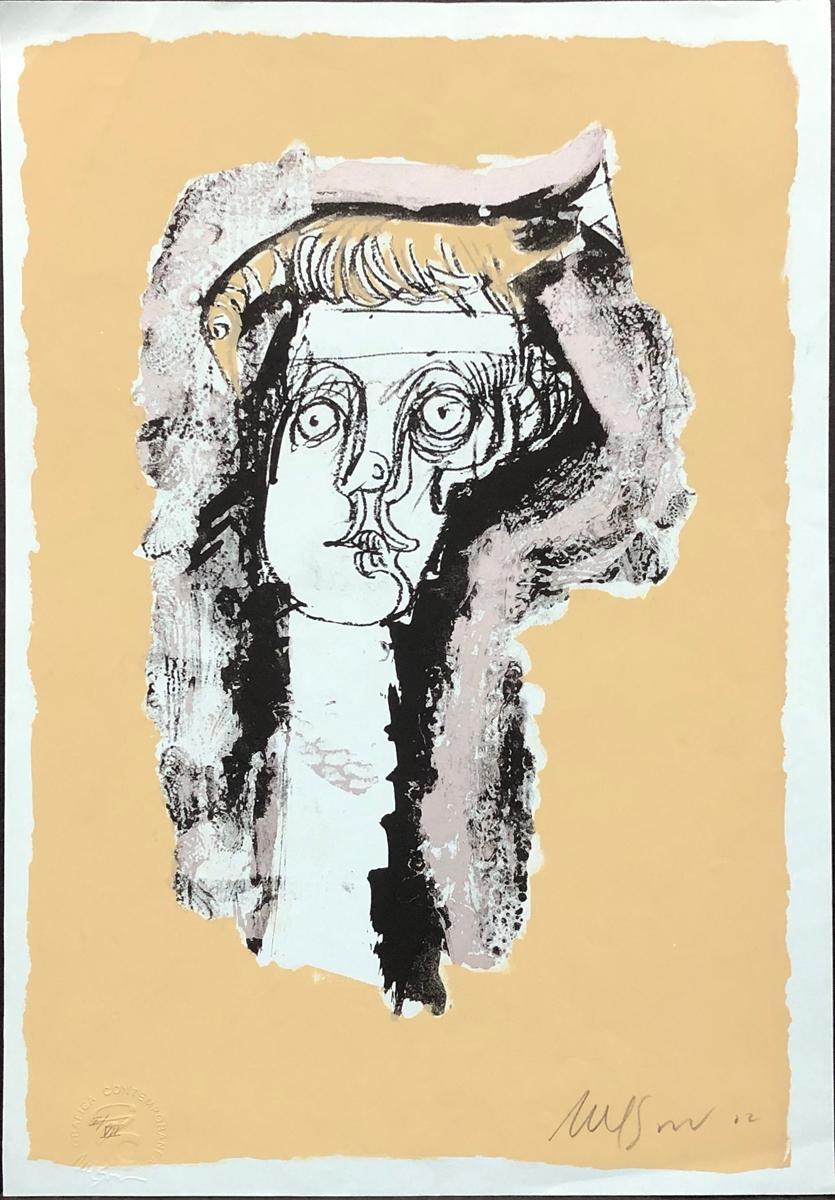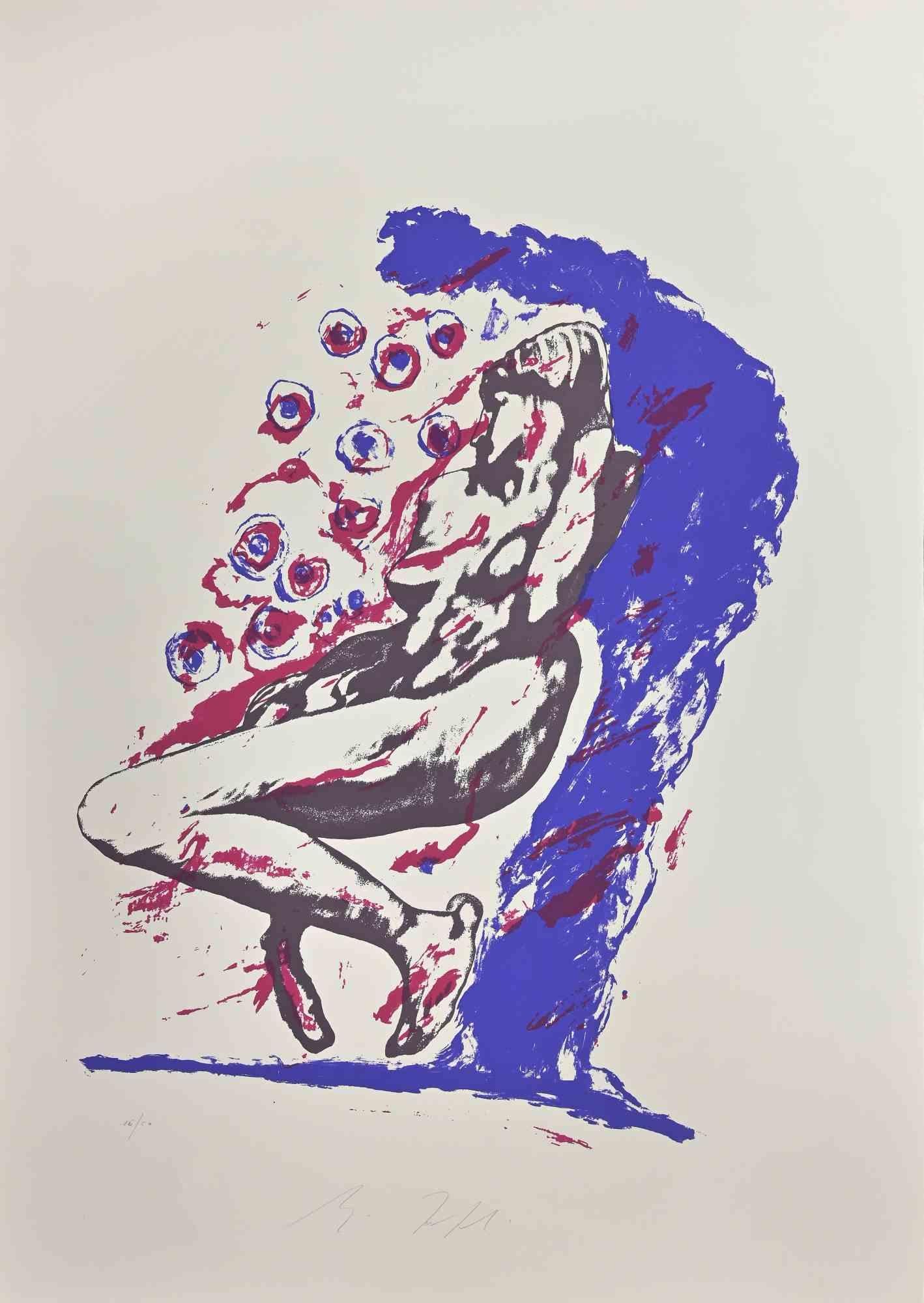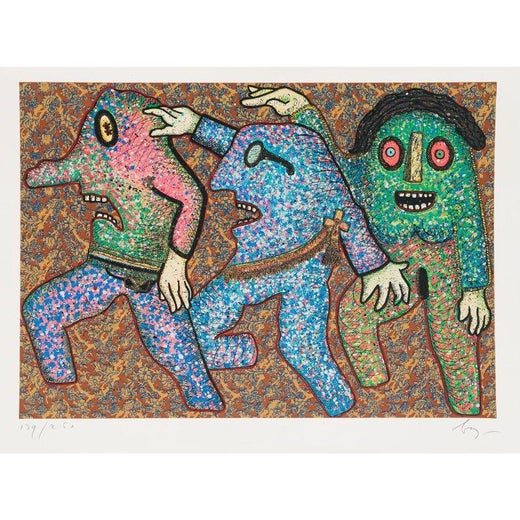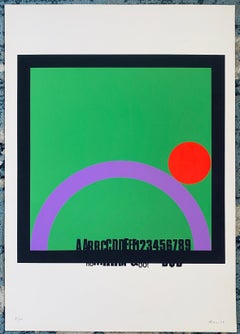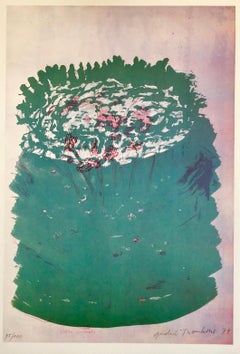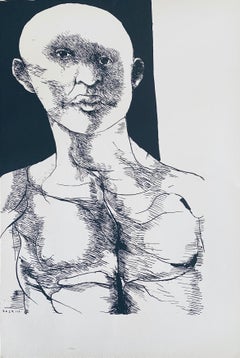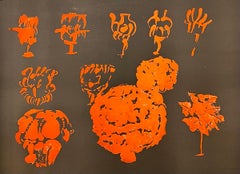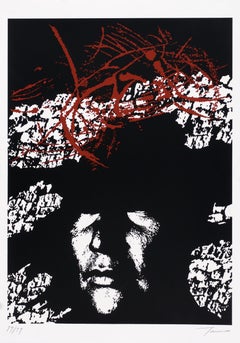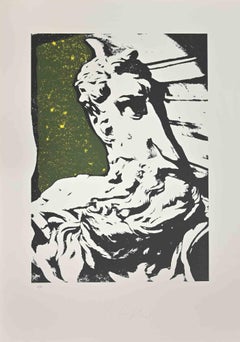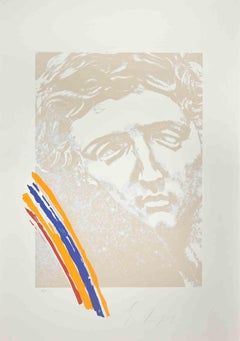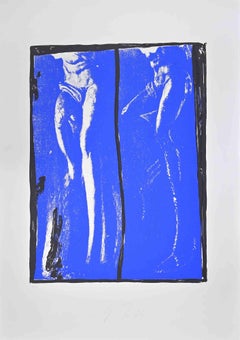Items Similar to Italian Surrealist Pop Art Serigraph Enrico Baj Pop Art Silkscreen Foil Print
Want more images or videos?
Request additional images or videos from the seller
1 of 13
Enrico BajItalian Surrealist Pop Art Serigraph Enrico Baj Pop Art Silkscreen Foil Printc.1975
c.1975
$1,100
£844.75
€968.08
CA$1,548.53
A$1,734.69
CHF 903.93
MX$21,159.69
NOK 11,486.92
SEK 10,831.35
DKK 7,225.46
About the Item
Enrico Baj (1924-2003) Italian, limited edition print.
Hand signed and numbered Signature on the corner. Edition 44 of 45. metallic silver aluminum.
Baj was an Italian artist best known for his political collages, prints, paintings, and sculptures. He was close to the surrealist and dada movements, and was later associated with CoBrA.
Italian artist Enrico Baj (1924-2003) was born in Milan into a wealthy family, but left Italy in 1944 having upset the authorities and to avoid conscription. He studied at the Milan University law faculty and the Brera Academy of Art. Italian Surrealist Pop Art.
Artist, attorney, ironist, writer, sharp critic, and political dissenter, Enrico Baj brought an urgent, refreshing and unique voice to the art of his time. In 1951 he founded the Movimento d'Arte Nucleare (the Nuclear Art Movement, or Art for the Nuclear Age) with Sergio D'angelo whose manifesto stated that its members "desire to demolish all the 'isms' of painting that inevitably lapses into academicism, whatever their origins may be." Baj took inspiration from the most radical notion of Surrealism (he joined the COBRA Group in the late 1940s), adhered to Ubu's sardonic and rocambolesque spirit and André Breton (in Le Surréalisme et la peinture) claimed him for his movement. His work was acclaimed by Gillo Dorfles as kitsch pioneer and embraced by artists like Asger Jorn, Marcel Duchamp Andy Warhol and Max Ernst. Baj's work reflected a necessity for continuous re-evaluation and renovation in which the experimental process took precedent over the realized objects. Enrico Baj was one of the most important contemporary Italian artists. Playing a leading role in the Fifties and Sixties avantgarde alongside Lucio Fontana, Asger Jorn, Manzoni and Yves Klein, Baj established close ties with Max Ernst, Marcel Duchamp, E. L. T. Mesens, and other artists of the Cobra group, Karel Appel and others, with New Realism, Surrealism and Pataphysics.
Baj's output includes his Modificazioni paintings (1959-60), a visual farce in which Baj modified kitschy commercial paintings in order to push further still the Dada anti-art idea, and his Idraulica series (2002) consisting of sculptures and assemblages made from hydraulic plumbing fittings.
Baj's Generali, gorilla-like figures with ferocious expressions, laid down upon a floral fabric background, whose effeminacy clashes with the general's predatory qualities, making them even more absurd and demonstrating both the comedy and the tragedy of the frail human ego as it searches for validation and self-worth. A series of his portraits, assemblages in which Baj address the absurdity of human self-perception and a critic to the provincialism of the Italian bourgeoisie will also be exhibited.
Previous main exhibitions include: The Art of Assemblage, MoMA, New York, 1961; Pittura a Milano dal 1945 al 1964, Milan, 1964; XXII Biennale di Venezia, Venice, 1964; Baj's at Marconi, Studio Marconi, Milan, 1967; Gemeentemuseum, L'Aja, 1967; Palazzo Grassi, Venice, 1971; Museum of Contemporary Art of Chicago, 1971; Enrico Baj. Opere 1951-2001, Palazzo delle Esposizioni, Roma, 2001/2002.
Many of his works show an obsession with nuclear war. He created prints, sculptures but especially collage. He was close to the surrealist and dada movements, and was later associated with CoBrA. As an author he has been described as a leading promoter of the avant-garde. He worked with Umberto Eco among other collaborators. He had a long interest in the pseudo-philosophy 'pataphysics.
In 1951 he founded the arte nucleare movement with Sergio D'Angelo, which unlike abstract art was overtly political. Baj himself was aligned with the anarchist movement. His most well-known pieces are probably the series of "Generals": absurd characters made from found objects such as belts or medals. This one has nude angel cherubs and nudes, mildly erotic, cartoon imagery.
He made numerous works using motifs from other artists, from Leonardo da Vinci to Pablo Picasso. Sometimes he recreated entire works of other painters.
Baj had his debut in New York in 1960, as part of the exhibition Surrealist Intrusion in the Enchanters’ Domain, organized by Marcel Duchamp and André Breton at D’Arcy Galleries. The following year, his work was included in the influential exhibition Art of Assemblage (1961), organized by William Seitz at the Museum of Modern Art, New York. In 1964 a room devoted to Baj’s work was presented in the 22nd Venice Biennial, and three major retrospectives followed in 1971, held at Palazzo Grassi, Venice; Museum of Contemporary Art, Chicago; and Musée de l’Athénée, Geneva. Recent exhibitions were held in the following venues, among others: the 55th Venice Biennial (2013), Fondazione Arnaldo Pomodoro, Milan (2013), and Palazzo delle Esposizioni, Rome (2001-2002).
- Creator:Enrico Baj (1924-2003, Italian)
- Creation Year:c.1975
- Dimensions:Height: 29.5 in (74.93 cm)Width: 22 in (55.88 cm)
- Medium:
- Movement & Style:
- Period:
- Condition:
- Gallery Location:Surfside, FL
- Reference Number:1stDibs: LU38210479562
Enrico Baj
Enrico Baj, born in Milan on October 31, 1924 and died in Vergiate on June 16, 2003, was an Italian painter, libertarian anarcho-pataphysician. In 1950, with the painter Sergio Dangelo, he founded the Nuclear Movement (or Movimento Arte Nucleare), considered the Italian equivalent of the CoBrA movement. In 1953, he approached the painter Asger Jorn with the aim of founding the International Movement for an imaginist Bauhaus and organized the International Ceramic Meetings of Albisola, in which the painters Matta and Roland Giguère took part. From 1955, he composed his paintings with the most heterogeneous elements such as pieces of glass, skeins of wool, mattress canvas, watch dials. That same year, with the writer Édouard Jaguer, he created the Italian magazine Il gesto. After meeting Mesens in London, Marcel Duchamp and Arturo Schwarz in New York, he met André Breton in Paris in 1962. From 1965, he began a series of collages representing ladies: Dame Ninette de Valois, 1974 and Generals in ceremonial costumes overloaded with decorations: Lieutenant John Talbot, First Earl of Shrewsbury.
About the Seller
4.9
Platinum Seller
Premium sellers with a 4.7+ rating and 24-hour response times
Established in 1995
1stDibs seller since 2014
1,788 sales on 1stDibs
Typical response time: <1 hour
- ShippingRetrieving quote...Shipping from: Surfside, FL
- Return Policy
Authenticity Guarantee
In the unlikely event there’s an issue with an item’s authenticity, contact us within 1 year for a full refund. DetailsMoney-Back Guarantee
If your item is not as described, is damaged in transit, or does not arrive, contact us within 7 days for a full refund. Details24-Hour Cancellation
You have a 24-hour grace period in which to reconsider your purchase, with no questions asked.Vetted Professional Sellers
Our world-class sellers must adhere to strict standards for service and quality, maintaining the integrity of our listings.Price-Match Guarantee
If you find that a seller listed the same item for a lower price elsewhere, we’ll match it.Trusted Global Delivery
Our best-in-class carrier network provides specialized shipping options worldwide, including custom delivery.More From This Seller
View AllItalian Artist Modern Silkscreen Eugenio Carmi
By Eugenio Carmi
Located in Surfside, FL
Eugenio Carmi is an Italian painter born in 1920 in Genoa. He studied in Turin in Felice Casorati’s studio. His experience as a graphic designer in the ‘50s, is decisive for his pict...
Category
1980s Modern Abstract Prints
Materials
Screen
1970s Modernist Swiss Colorful Surrealism Signed Dada Lithograph Andre Thomkins
By André Thomkins
Located in Surfside, FL
This one is titled "Little Animals" and depicts drawings of small animals over an abstract forest background in green, red and tan with a quali...
Category
1970s Surrealist Figurative Prints
Materials
Lithograph, Offset
Leonard Baskin Plate Signed Illustration Print American Modernist Lithograph
By Leonard Baskin
Located in Surfside, FL
Leonard Baskin (August 15, 1922 – June 3, 2000) was an American sculptor, illustrator, wood-engraver, printmaker, graphic artist, writer and teacher.
Baskin was born in New Brunswick, New Jersey. While he was a student at Yale University, he founded Gehenna Press, a small private press specializing in fine book production. From 1953 until 1974, he taught printmaking and sculpture at Smith College in Northampton, Massachusetts. Subsequently Baskin also taught at Hampshire College in Amherst, Massachusetts.
He lived most of his life in the U.S., but spent nine years in Devon at Lurley Manor, Lurley, near Tiverton, close to his friend Ted Hughes, for whom he illustrated Crow. Sylvia Plath dedicated Sculpto to Leonard Baskin in her famous work, The Colossus and Other Poems (1960).
The Funeral Contege (1997) bronze, Franklin Delano Roosevelt Memorial, Washington, D.C.
His public commissions include a bas relief for the Franklin Delano Roosevelt Memorial and a bronze statue of a seated figure, erected in 1994 for the Holocaust Memorial in Ann Arbor, Michigan.
His works are owned by many major museums including the Metropolitan Museum of Art, the Museum of Fine Arts, Boston, the Museum of Modern Art, the Art Institute of Chicago, the Boca Raton Museum of Art, the British Museum, the Honolulu Museum of Art, the Udinotti Museum of Figurative Art and the Vatican Museums. The archive of his work at the Gehenna Press was acquired by the Bodleian Library at Oxford, England, in 2009. The McMaster Museum of Art in Hamilton, Ontario owns over 200 of his works (some religious and biblical), most of which were donated by his brother Rabbi Bernard Baskin.
In 1955, he was one of eleven New York artists featured in the opening exhibition at the Terrain Gallery, they showed many great artists, Chaim Koppelman, for many years, headed the gallery's Print Division; printmakers such as Will Barnet, Leonard Baskin, Robert Conover...
Category
20th Century Modern Figurative Prints
Materials
Black and White, Lithograph
Pietro Consagra Italian Mod Abstract Expressionist Forma Art Informel Lithograph
By Pietro Consagra
Located in Surfside, FL
Pietro Consagra (Italian, 1920-2005).
Hand signed in pencil and numbered limited edition color lithograph on Magnani paper.
Embossed stamp with limited edition numbers in pencil to lower left, and having artist pencil signature to lower right.
(from a limited edition of 80 with 15 artist's proofs)
Published by Stamperia 2RC, Rome Italy and Marlborough Gallery, Rome, Italy.
Abstract Modernist work in colors, produced in the style of the Forma art movement of Postwar Italy, of which the artist was a prominent member.
Pietro Consagra (1920 – 2005) was an Italian Post war artist working in painting, printmaking and sculpture. In 1947 he was among the founding members of the Forma 1 group of artists, proponents of structured abstraction. (similar to the Art Informel and Art Brut in France and the Brutalist artists)
Consagra was born on 6 October 1920 in Mazara del Vallo, in the province of Trapani in south-western Sicily, to Luigi Consagra and Maria Lentini. From 1931 he enrolled in a trade school for sailors, studying first to become a mechanic, and later to become a captain. In 1938 he moved to Palermo, where he enrolled in the liceo artistico; despite an attack of tuberculosis, he graduated in 1941, and in the same year signed up at the Accademia di Belle Arti, where he studied sculpture under Archimede Campini. After the Invasion of Sicily and the Allied occupation of Palermo in 1943, Consagra found work as a caricaturist for the American Red Cross club of the city; he also joined the Italian Communist Party. Early in 1944, armed with a letter of introduction from an American officer, he travelled to Rome. There he came into contact with the Sicilian artist Concetto Maugeri, and through him with Renato Guttuso, who was also Sicilian and who introduced him to the intellectual life of the city and to other postwar artists such as Leoncillo Leonardi, Mario Mafai and Giulio Turcato. Consagra signed up at the Accademia di Belle Arti di Roma in September 1944 and studied sculpture there under Michele Guerrisi, but left before completing his diploma.
In 1947, with Carla Accardi, Ugo Attardi, Piero Dorazio, Mino Guerrini, Achille Perilli, Antonio Sanfilippo and Giulio Turcato, Consagra started the artist's group Forma 1, which advocated both Marxism and structured abstraction.
Steadily Consagra's work began to find an audience. Working primarily in metal, and later in marble and wood, his thin, roughly carved reliefs, began to be collected by Peggy Guggenheim and other important patrons of the arts. He showed at the Venice Biennale eleven times between 1950 and 1993, and in 1960 won the sculpture prize at the exhibition. During the 1960s he was associated with the Continuità group, an offshoot of Forma I, and in 1967 taught at the School of Arts in Minneapolis. Large commissions allowed him to begin working on a more monumental scale, and works of his were installed in the courtyard of the Foreign Ministry in Rome and in the European Parliament, Strasbourg. His work is found in the collections of The Tate Gallery, London, in Museo Cantonale d'Arte of Lugano and the Museum of Modern Art, Paris, and the National Gallery of Art in Washington, D.C..
Consagra returned to Sicily where he sculpted a number of significant works during the 1980s. With Senator Ludovico Corrao, he helped created an open-air museum in the new town of Gibellina, after the older town had been destroyed in the earthquake of 1968. Consagra designed the gates to the town's entrance, the building named "Meeting" and the gates to the cemetery, where he was later buried.
In 1952 Consagra published La necessità della scultura ("the need for sculpture"), a response to the essay La scultura lingua morta ("sculpture, a dead language"), published in 1945 by Arturo Martini. Other works include L'agguato c'è ("the snare exists", 1960), and La città frontale ("the frontal city", 1969). His autobiography, Vita Mia, was published by Feltrinelli in 1980. In 1989 a substantial retrospective exhibition of work by Consagra was shown at the Galleria Nazionale d'Arte Moderna in Rome; in 1993 a permanent exhibition of his work was installed there. In 1991 his work was shown in the Hermitage Museum in St. Petersburg. In 2002 the Galerie der Stadt Stuttgart opened a permanent exhibition of his work. He was one of ten artists invited by Giovanni Carandente, along with David Smith, Alexander Calder, Arnaldo Pomodoro, Lynn Chadwick, and Beverly Pepper, to fabricate works in Italsider factories in Italy for an outdoor exhibition, "Sculture nella città", held in Spoleto during the summer of 1962. He was included in the The 1962 International Prize for Sculpture the jury included Argan, Romero Brest and James Johnson Sweeney the former director of the Solomon R. Guggenheim Museum in New York. The participants included Louise Nevelson and John Chamberlain for the United States; Lygia Clark for Brazil; Pietro Consagra, Lucio Fontana, Nino Franchina, and Gió Pomodoro for Italy; Pablo Serrano for Spain; and Eduardo Paolozzi, William Turnbull, and Kenneth Armitage for England. Gyula Kosice, Noemí Gerstein, Julio Gero, Naum Knop...
Category
1960s Abstract Expressionist Abstract Prints
Materials
Lithograph
Still Life with Hans Maler Pop Art Serigraph Hand Signed
By Josef Levi
Located in Surfside, FL
On deckle edged watermarked Arches French paper. hand signed in pencil, dated and numbered. the edition size is 175.
there are three states of the same image image each with increasing detail and color. This is just for the one in the photo.
Josef Alan Levi (1938) is an American artist whose works range over a number of different styles, but which are unified by certain themes consistently present among them. Josef Levi began his artistic career in the 1960s and early '70s, producing highly abstract and very modernist pieces: these employing exotic materials such as light fixtures and metallic parts. By 1975, Levy had transitioned to painting and drawing still lifes. At first these were, traditionally, of mundane subjects. Later, he would depict images from art history, including figures originally created by the Old Masters. Around 1980, he made another important shift, this time toward creating highly precise, though subtly altered reproductions of pairs of female faces which were originally produced by other artists. It is perhaps this work for which he is most well known. Since around 2000, Josef Levi has changed the style of his work yet again: now he works entirely with computers, using digital techniques to abstract greatly from art history, and also from other sources.
Levi's works of art in the collections of the Museum of Modern Art, NYC, the National Gallery of Art, and the Albright-Knox Museum, among many others. Levi's art has been featured on the cover of Harper's Magazine twice, once in June 1987, and once in May 1997.
Josef Levi received a Bachelor of Arts degree in 1959 from the University of Connecticut, where he majored in fine arts and minored in literature. From 1959 to 1960, he served to a first lieutenant in the U.S. Army, and from 1960 through 1967 he was in the U.S. Army Reserves.
In 1966, he received the Purchase Award from the University of Illinois in 1966, and he was featured in New Talent U.S.A. by Art in America. He was an artist in residence at Appalachian State University in 1969, taught at Farleigh Dickenson University in 1971 and was a visiting professor of art at Pennsylvania State University in 1977. From 1975 to 2007, Levi resided in New York City. He now lives in an apartment in Rome, where he is able to paint with natural light as he was unable in New York.
From 1959 to 1960, Josef took some courses of Howard McParlin Davis and Meyer Schapiro at Columbia University which initiated him into the techniques of reproducing the works of the Old Masters. His first works, created in the 1960s, were wood and stone sculptures of women. His first mature works were abstract pieces, constructed of electric lights and steel.
In 1970, Levi's materials included fluorescent light bulbs, Rust-Oleum and perforated metal in addition to paint and canvas.
By 1980, Josef Levi's art had transformed into a very specific form: a combination of reproductions of female faces which were originally depicted by other artists. The faces which he reproduces may be derived from either portraits or from small portions of much larger works; they are taken from paintings of the Old Masters, Japanese ukiyo-e, and 20th-century art. Artists from whom he has borrowed include: Vermeer, Rembrandt, Piero della Francesca, Botero, Matisse, Utamaro, Correggio, Da Vinci, Picasso, Chuck Close, Max Beckmann, Pisanello, Lichtenstein. The creation of these works is informed by Levi's knowledge and study of art history.
Josef Levi's paintings from this period are drawn, then painted on fine linen canvas on wooden stretchers. The canvas is coated with twenty-five layers of gesso in order to produce a smooth surface on which to work. The drawing phase takes at least one month. Levi seals the drawing with acrylic varnish, and then he may apply layers of transparent acrylic in order to approximate the look of old paintings. After the last paint is applied, another layer of acrylic varnish is sprayed on to protect the work.
Most of the figures in his contemporary pieces are not paired with any others.
SELECTED COLLECTIONS
MUSEUM OF MODERN ART, NEW YORK, NY
ALBRIGHT- KNOX GALLERY, BUFFALO, NY
ALDRICH MUSEUM OF CONTEMPORARY ART, RIDGEFIELD, CT
NATIONAL GALLERY OF ART, WASHINGTON, DC
BROOKLYN MUSEUM OF ART, BROOKLYN, NY
SMITHSONIAN NATIONAL MUSEUM OF AMERICAN HISTORY, WASHINGTON, DC
CORCORAN GALLERY, WASHINGTON, DC
UNIVERSITY OF NOTRE DAME ART...
Category
1970s Pop Art Figurative Prints
Materials
Lithograph, Screen
Large Silkscreen Serigraph Neo Figurative Expressionist Print Jorg Immendorff
By Jörg Immendorf
Located in Surfside, FL
Jorg Immendorff (German, 1945-2007)
Untitled, Germany, 2006
serigraph
hand signed and dated lower right margin, numbered 20/27 lower left
framed
74.5 x 48.75 inches (sight).
82.25 x 55.5 inches (frame).
This work is number 20 from the edition of 27.
Provenance: T. Kreuzer Gallery, Cologne, Friedman Benda Gallery, New York City
Jörg Immendorff (1945–2007) was a German painter, sculptor, stage designer and art professor. He was a member of the art movement Neue Wilde. He worked as a painter, sculpture and print maker in steel, bronze, oil painting, lithography etching and serigraphy.
Immendorff was born in Bleckede, Lower Saxony, near Lüneburg on the west bank of the Elbe. He attended the boarding School Ernst-Kalkuhl Gymnasium as a student. At the age of sixteen he had his first exhibition in a jazz hall cellar in Bonn.
Beginning in 1963, Immendorff studied at the Art Academy in Düsseldorf (Kunstakademie Düsseldorf). Initially he studied for three terms with the theater designer Teo Otto. After Otto threw him out of his class for refusing to let one of his paintings serve as stage-set decoration, Immendorff was accepted as a student by Joseph Beuys. The academy expelled him because of some of his (left-wing) political activities and neo-dada actions.
From 1969 to 1980, Immendorff worked as an art teacher at a public school, and then as a free artist, holding visiting professorships all over Europe. In 1989, he became professor at the Städelschule in Frankfurt am Main and in 1996 he became professor at the Art Academy in Düsseldorf—the same school that had dismissed him decades earlier as a student.
Jörg Immendorff often worked in "grand cycles of paintings" that often lasted years at a time and were political in nature. Notable cycles include LIDL, Maoist Paintings, Cafè Deutschland , and The Rake's Progress. The first body of work that Immendorff gave a name to were his LIDL paintings, sculptures, performances, and documents, that he executed during 1968-1970. The name, "LIDL" was inspired by the sound of a child's rattle makes and much of his work from this period included the iconography of new beginnings and innocence. LIDL is comparable to Dadaist but unlike the Dada movement it never became an established group but rather consisted of a variety of artists (including James Lee Byars, Marcel Broodthaers, Nam June Paik, and Joseph Beuys) participating in actions and activities.
In January 1968 he appeared in front of the West German Parliament in Bonn with a wood block labeled “Lidl” tethered to his ankle and painted in the colors of the German flag; he was subsequently arrested for defaming the flag.
Best known is his Cafe Deutschland series of sixteen large paintings (1977–1984) that were inspired by Renato Guttuso Caffè Greco; in these crowded colorful pictures, Immendorff had disco-goers symbolize the conflict between East and West Germany. Since the 1970s, he worked closely with the painter A. R. Penck from Dresden (in East Germany).
Immendorff created several stage designs, including two for the Salzburg Theater Festival. He designed sets for the operas Elektra and The Rake's Progress. The latter also inspired a series of paintings in which he cast himself as the rake.
In 1984, Immendorff opened the bar La Paloma near the Reeperbahn in Hamburg St. Pauli and created a large bronze sculpture of Hans Albers there. He also contributed to the design of Andre Heller's avant-garde amusement park "Luna, Luna" in 1987. Immendorff created various sculptures; one spectacular example is a 25 m tall iron sculpture in the form of an oak tree trunk, erected in Riesa in 1999. In 2006, Immendorff selected 25 of his paintings for an illustrated Bible. In the foreword he described his belief in God.
A major 2019 survey began at the Haus der Kunst in Munich and later traveled later to the Museo Reina Sofía in Madrid and the Fondazione Querini Stampalia in Venice, curated by Francesco Bonami. In 2000, Immendorff married his former student Oda Jaune. The have one daughter Ida Immendorff. He was a member of the Junge Wilde (German for "young wild ones")
In 1978, the Junge Wilde painting style arose in the German-speaking world in opposition to established avant garde, minimal art and conceptual art. It was linked to the similar Transavanguardia movement in Italy, USA (neo-expressionism) and France (Figuration Libre). The Junge Wilde painted their expressive paintings in bright, intense colors and with quick, broad brushstrokes very much influenced by Professor at the Academy of Art in Berlin, Karl Horst Hödicke (b:1938). They were sometimes called the Neue Wilde. Berlin: Luciano...
Category
Early 2000s Neo-Expressionist Abstract Prints
Materials
Screen
You May Also Like
Argentinean Artist signed limited edition original art print silkscreen
Located in Miami, FL
Luis Rodolfo Trimano (Argentina, 1943)
'Estigmas 3', 2006
silkscreen on paper
39.4 x 27.6 in. (100 x 70 cm.)
Edition of 99
Unframed
ID: TRI1706-003-106
Hand-signed by author
Category
Early 2000s Contemporary Prints and Multiples
Materials
Paper, Engraving, Screen
Michelagnolo - Screen print by Mino Trafeli - 1984
Located in Roma, IT
Screenprint, numbered and signed, by the Italian artist Mino Trafeli (Volterra, Italy 1922-2018).
Part of a portfolio of 13 5-color serigraphs made by Mino Trafeli and printed, with...
Category
1980s Modern Figurative Prints
Materials
Paper, Screen
Michelagnolo - Screen print by Mino Trafeli - 1984
Located in Roma, IT
Screenprint, numbered and signed, by the Italian artist Mino Trafeli (Volterra, Italy 1922-2018).
Part of a portfolio of 13 5-color serigraphs made by Mino Trafeli and printed, with...
Category
1980s Modern Figurative Prints
Materials
Paper, Screen
$425 Sale Price
25% Off
Michelagnolo - Screen print by Mino Trafeli - 1984
Located in Roma, IT
Screenprint, numbered and signed, by the Italian artist Mino Trafeli (Volterra, Italy 1922-2018).
Part of a portfolio of 13 5-color serigraphs made by Mino Trafeli and printed, with...
Category
1980s Modern Figurative Prints
Materials
Paper, Screen
Nelson Dominguez Original Hand Signed silkscreen Cuban Artist
Located in Miami, FL
Nelson Dominguez (Cuba, 1947)
'Untitled', 2012
silkscreen on paper
18.2 x 12.6 in. (46 x 32 cm.)
Edition of 7
ID: DOM-307
Hand-signed by author
_______________________________________
"Biography. Nelson DOMÍNGUEZ.
Born: 1947, Santiago de Cuba, Cuba.
Studies: 1970 National School of Art, Cuba.
Experience: 1970 - 1985 Professor National School of Art, Cuba. He has been Professor of Painting and Engraving and Head of the Painting Department of the Higher Institute of Art (ISA). Member of the Union of Writers of Cuba and the International Association of Plastic Artists.
Awards: Among the awards and recognitions that the Cuban artist received: Order for the National Culture, Cuba; Order Alejo Carpentier, Cuba; Diploma and Order of Honor from the Fuji Museum, Japan. In 1972, he received the National Prize at the International Painting Festival in Cagnes-sur-mer, France; 1976 Grand Prize, International Biennial of Wood Engraving, Banska Bystrika, Czechoslovakia and Painting Prize, Triennial of Committed Realist Art, Sofia, Bulgaria; Honor Prize, Graphic Biennial, India, as well as at the Jaime Guasch Biennial in Barcelona, Spain.
Exhibitions In summary, exhibitions of personalities. In 1983 he made the exhibition ""Retrospective (10 years of professional work)"" at the National Museum of the Palace of Fine Arts of Cuba, in 1984 at the Francoise Tournie Gallery in Paris; in 1985 he did it in the National Welfare Organization of Athens, Greece and in 1986 in the Gallery del l 'Incisione in Venice, Italy. During the eighties and nineties his work was shown in Brazil, Italy, Puerto Rico, Japan, Mexico, Spain, the United States, Cuba and Mexico. In 2001, an individual exhibition was held at the Hotel Trip Cayo Coco in Cuba.
Collections: Many of his works are exhibited in the Los Oficios Studio Gallery, Old Havana, Cuba and in the collections of the National Museum of Fine Arts of Cuba, Merugo Museum of Japan; Herbeat F. Johnson Museum of Art of the United States; The Presidential House, Los Pinos, of Mexico; Alejo Carpentier Foundation and José...
Category
2010s Contemporary Figurative Prints
Materials
Screen
Michelagnolo - Screen print by Mino Trafeli - 1984
Located in Roma, IT
Screenprint, numbered and signed, by the Italian artist Mino Trafeli (Volterra, Italy 1922-2018).
Part of a portfolio of 13 5-color serigraphs made by Mino Trafeli and printed, with...
Category
1980s Modern Figurative Prints
Materials
Paper, Screen
More Ways To Browse
Cherub Prints
Vintage Kitsch Art
Picasso Erotic Art
Pablo Picasso Screen Print
Vintage Cherub Angels
Andy Warhol Self Portrait Signed
Gorilla Sculpture
Picasso Serigraph
Gorilla Painting
Andy Warhol Angel
Warhol Serigraph
Picasso Human Comedy
Pablo Picasso Serigraph
Jean Cocteau Book
Keith Haring Untitled
Notre Dame Lithograph
Nurse Vintage Art
Paper Press Machine
